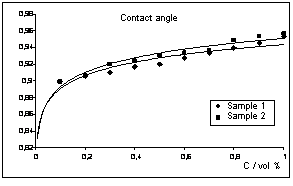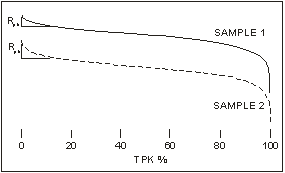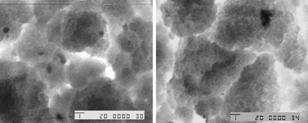
Abstract: The surface structure of the offset printing forms the key factor in functioning of the conventional planographic printing, according to its physical-chemical surface properties as well as according to its geometry. One of the greatest causes of physical-chemical changes on the surface is in most cases the processing of the printing forms, i.e. the development of the printing forms. Because of that physical-chemical as well as geometrical changes in the surface microstructure of the printing forms have been observed, caused by the processing conditions of the printing forms and the composition of the developing solution. The changes of the properties of the nonprinting areas by measuring the surface roughness and by SEM analysis have been exclusively observed. The investigations showed that determined physical – chemical changes as well as the geometrical ones appeared. These changes can have considerable influence on the application of the wetting solution on the printing form and on the correct water ink balance during the printing process.
Key words: offset printing, CtP plates, nonprinting elements, roughness, SEM analysis
1. INTRODUCTION
The production of the printing forms and especially their processing after imaging has an important role in the reproduction process. The processing of CtP of thermal printing forms used in this investigation includes the processing of the printing forms in the chemical developing process. By the development of the direct computer controlled imaging of the printing forms (CtP) and thermal active layers (Adams & Romano, 1996), there is the trend of creating the “processes” printing forms, i.e. creating of such forms which do not require the process of chemical developing (Walls, 1994). The reason for that is a great number of parameters that can easily vary in the developing process and that can influence the obtaining of printing forms of lower quality. It is the question of keeping the constant processing conditions, keeping the correct concentration of the developer components, developing speed, temperature etc. Nevertheless the most represented printing forms today in the graphic reproduction are CtP thermal printing plates which demand the processes of after-treatment by developing (Hare et al., 1997). Because of that they are the topic of that work. During the development, chemical interaction between the developer and the surface of the printing form can influence the difference in shape and sharpness of the printing elements. If the processing conditions of the printing form are not satisfactory it is supposed that the wetting solution can aggressively act on the surface of the Al 2 O 3 . This could influence the decrease of hydrophilic ability of the nonprinting areas ( Al 2 O 3 surface) and the appearance of scumming in printing.
2. BACKGROUND
The technique of the planographic printing is based on the selective wetting of the nonprinting areas by the wetting solution and the wetting of the printing elements by the printing ink. In order to achieve the printing process, the printing and nonprinting areas must differ in their physical – chemical properties. The nonprinting areas are hydrophillic, they attract water. The printing areas are oleophilic i.e. hydrophobic because they absorb printing ink which is produced on the basis of oil and resins. Hydrophobic ability is not much expressed and that is the reason why the wetting solution is applied first on the printing form during the printing process. The wetting solution is adsorbed onto the nonprinting areas and the printing ink is adsorbed on the printing areas and prevents scumming in offset.
Digital printing forms which are used in the planographic printing process today are mostly pre-coated aluminum foils with the medium arithmetic roughness profile aberration R a =1.5 m m (Zivkovic et al., 2000) . In production of aluminum foils, the aluminum surface is anodized and the layer of Al 2 O 3 . is formed Because of its polarity Al 2 O 3 has more expressed hydrophilic properties than aluminum. Such oxide coating on metals essentially changes their properties, because metal takes over the properties of the oxide coating which has in a rule the polar character. Such surface will absorb the polar molecules of water. For plate production the nonprinting areas are treated by surfactants which increase their hydrophilic ability and on the printing areas they increase their oleophilic ability.
Why is hydrophilic ability of the nonprinting areas important? By absorption of the salts for hydrophilization from the wetting solutions, the hydrophilic ability of the nonprinting areas on the printing form and offset plate is kept, which influences the stability of the print quality. The quality of the absorbed liquid depends on the technologically caused wetting solution, on the specific surface which is it proportional to and generally on the surface phenomena.
3. EXPERIMENTAL
The investigations were performed on CtP printing forms with the thermo active layer. The activity of IR radiation results in thermal disintegration in the thermo active layer and it becomes soluble in the developer. By removing the imaged areas during the developing process, the hydrophilic area of Al 2 O 3 which makes the nonprinting areas and the not imaged areas of polymer form the printing areas.
The performed investigations are based on the fact that the changes in physical chemical properties of the nonprinting areas as well as the changes in the surface microstructure of the printing forms directly influence the quality of the reproduction (Lovrecek et al, 1999). Physicochemical parameter, which greatly influences the whole printing process, is pH value of the fountain solution, electrical conductivity, contact angle and surface tension. The narrow area of pH value is caused by corrosion stability of the bohemitic structure Al 2 O 3 as the material forming the non-printing areas, steel parts and chromium coatings on the machine parts ( Gojo et al., 2004). Except the influence on damping of the printing plate, pH value considerably influences the oxypolymerization, viscosity, tackiness and tinctorial strength of the ink as well as corrosion of the machine parts.
The samples of the damping solution are prepared by mixing the concentrate with the demineralized water in the concentration of 2.5 vol%. Measurements of the contact angle were performed by goniometer NPL C.A. model N A-100 of the firm Rame-Hart. The solution samples were measured by means of the immersing method ( Dragcevic et al., 2002) . For measuring the surface roughness mechanical-chemical measuring instrument Perthometer S8P with feeler was used, which enabled the measurements of the material surfaces, graphic presentation, data processing and surface profile protocoling.
4. RESULTS AND DISCUSSION
The imaging was done in the same defined conditions, but the surface processing of the printing forms was different. The samples of the printing form were developed in the alkaline developer of high (sample 1) and low (sample 2) pH value. Depending on concentration of the wetting solution their physical chemical properties were investigated, such as: pH value, surface tension and electric conductivity, and the contact angle were determined on the nonprinting areas of the thermal printing forms. The results of the changes in the contact angle are visible in figure 1.
![]()

Fig. 1. Measuring results of the contact angle.
Caused by the developing conditions of the printing forms, geometrical changes in microstructure of the nonprinting areas appear. By determination the roughness parameters relevant for the description of nonprinting areas one can see the decrease of R pk values from 0.418 to 0.364 (Fig. 2). This points at the negative activity of the developer on the surface Al 2 O 3 .

Fig. 2. Changes R pk roughness parameter on CtP printing forms
Namely, Al and Al 2 O 3 are amphotheric, they equally dissolve in acids and alkalines forming soluble salts (Shriver & Atkins 1999). It is obvious that the alkaline character of the developer influences the dissolution of the peaks in the
structure Al 2 O 3 , and the change of the microstructure of the nonprinting areas of the printing form which is visible on the surface photos of the SEM analysis (Fig. 3). By roughness decrease and by removing all the active points the decrease of the surface and weaker absorption of the wetting solution appear which results in the decrease of the contact angle as the measure of the successful wetting of the printing forms.

Fig. 3. SEM analysis of sample 1 (left) and sample 2 (right).
4. CONCLUSION
The geometry of the printing surface and the changes on the surface during reproduction, present an important segment in achieving prints of satisfying quality. The obtained results show that in dependence on the developer quality, i.e. on its pH value considerable changes of the nonprinting areas appear. It is visible in the decrease of the values of the roughness parameters caused by the dissolving of the anodic layer of Al 2 O 3 .
This dissolving leads to the decrease of the active surface for absorption and to the smaller quantity of the wetting solution. The increase of the contact angle can cause weaker wetting of the nonprinting areas and additional problems in the planographic printing process. These problems are most often expressed in disturbing the optimal balance of wetting solution and printing ink during the printing process and in appearance of scumming on prints.
5. REFERENCES
Adams Richard M., Romano F. (1996). Computer to Plate: Automating the Printing Industry , Graphic Arts Technical Foundation, ISBN 0-88362-191-6, USA
Dragcevic, K.; Gojo, M. & Agic, D. (2002). Investigations of Physicochemical Properties of Fountain Solution in the Function of Printing Quality Prediction, Proceedings of 13 th International DAAAM Symposium , Katalinic, B., 141-142, ISBN 3-901509-29-1, Austria, October 2002, Daaam Int., Vienna
Gojo, M., Mahović, S., Agić, D., Mandić, L. (2004). The Influence of Paper on Physical-Chemical Characteristics of Fountain Solution, Chapter 22, In: DAAAM International Scientific Book, B. Katalinić (Ed.), pp. 219-230, Published by DAAAM International, ISBN: 3-901509-38-0, Vienna, Austria
Hare D. E., Dlott D. D., D'Armato R. J., Lewis T. E. (1997). Fundamental Mechanisms of Lithographic Printing Plate Imaging by near – Infrared Lasers, J. Imag. Sci. Tech.
Lovreček M., Gojo M., Dragčević K. (1999). Advances in Printing Science and Technology, Vol. 25, Pira International, Surrey UK
Shriver, D. F. & Atkins, P. W. (1999). Inorganic Chemistry , 3 rd Edition, W. H. Freeman and Company, NY
Walls J. E. (1994). Unconventional Printing Plate exposed by IR (830) Laser Diodes , TAGA Proceedings, Rochester (NY), (1994), 259-267.
Zivkovic, P. M., Jovanovic, S., Popov, K. I., Ilić, N. (2000). Modification of the aluminium for making offset printing plates, J. Serb. Chem. Soc., 65, 12, 2000, pp. 935-938